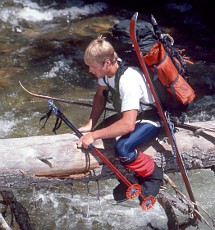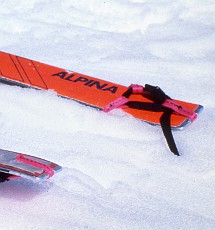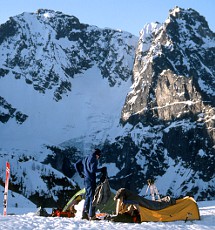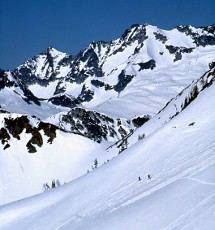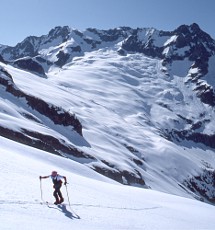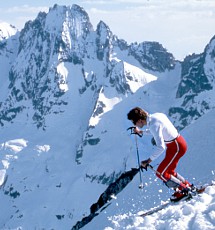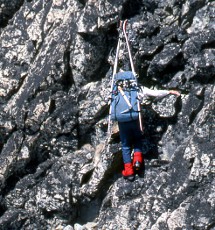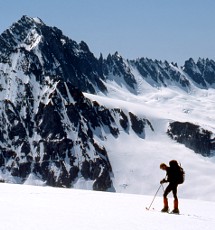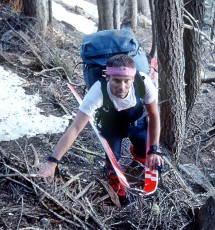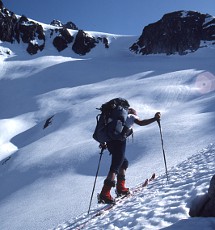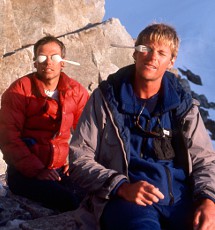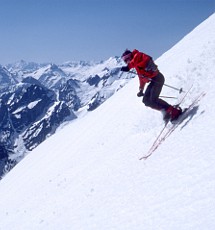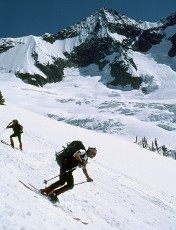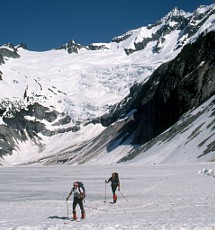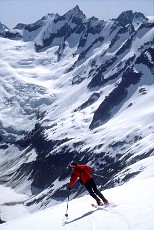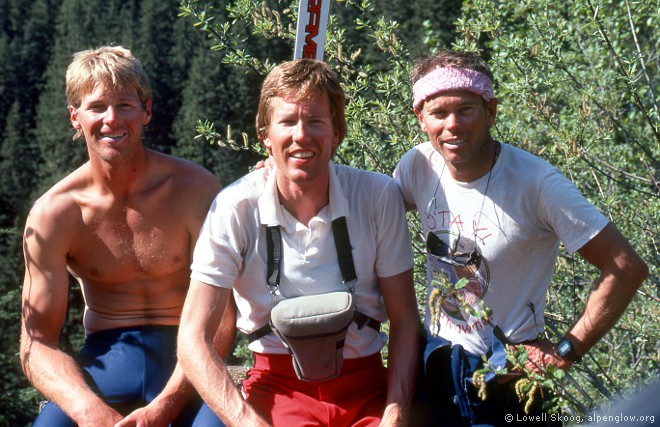 |
|
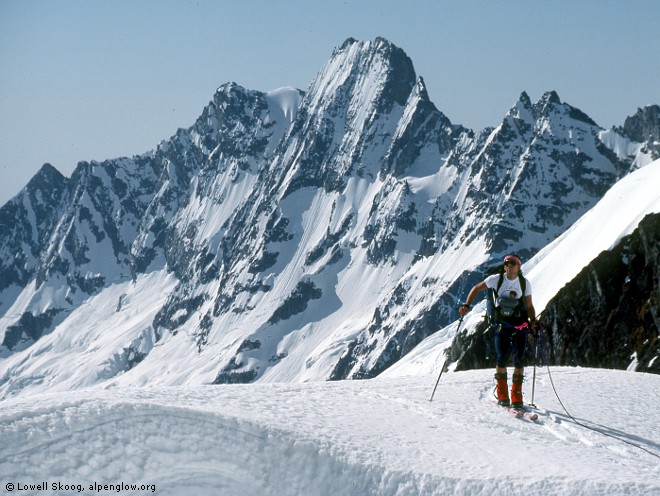 |
|
| Jens Kieler on Mount Logan's Douglas Glacier, May 1987. Mount Goode is in the distance. (Topo, 750kb. Sketch map. Click photos to enlarge.) | |
|
I submitted this story to Climbing magazine in
1987. The article was poorly edited and was published under
the title “Coming of Age: An Increasingly Popular Ski
Tour” in the December issue. Editor Michael Kennedy
later apologized for the magazine's handling of the piece. I've
returned to my manuscript to present this story as it was
originally intended, with a few updates.
—Lowell Skoog
Jens switched the car into four-wheel drive and charged into the snowpatch. Wet snow sprayed in our wake as we bounced and fishtailed to bare ground a hundred feet farther up the road. I looked over my shoulder and watched Dan plow into our track, his two-wheel drive car nearly floundering to a stop before reaching our side of the snow. Beyond that point the snowpatches were small, so we reached the end of the road with little trouble, the first cars to make it this season. It was a bright spring morning in the North Cascades. Hidden
Lake Peak glowed in the sunlight as we loaded our skis and packs
into Dan's car and started back down the road. The slopes of
the peak were inviting, but they would have to wait. Our ski
traverse started on the other side of the range. If everything
went well we would see Hidden Lake Peak again four days later.
Spring in the North Cascades is a time of transition. The highest summits are still chiseled in ice. The steepest rock walls are shedding their winter coat in thundering avalanches. The valleys are snowbound, but as the days lengthen and more settled weather consolidates the snow, access becomes practical. There are a few weeks each year between the end of winter storms and the melting of the snowpack when conditions are right for extended ski trips in the North Cascades. From previous experience, Jens Kieler and I knew it was impossible to predict when the weather would clear. We had to scramble—working extra hours, rearranging schedules—straining to mold the routine of our regular jobs to the whims of Cascade weather. Dan Nordstrom had never been on a traverse like this, but he was excited by my descriptions. I knew we would be away from the crowds. Across the glaciers and gleaming ridges, our ski tracks would be unseen by anyone else. In a few days they would disappear without a trace.
We drove east along the North Cascades Highway for an hour then pulled over and unloaded the car. The air was filled with the sound of rushing water and the smell of the forest. I had crammed three days of work into a two-day weekend in order to get time off for this trip. After the hectic pace of the past few days, the morning soothed my harried soul. We stumbled through the woods to Granite Creek then straddled a log to cross the stream. After an hour of skiing we emerged from the forest into a narrow basin beneath the walls of Fisher and Repulse Peaks. A clear, snowy corridor extended to the head of the valley and, in my imagination, all the way to the end of the traverse. If all went well, we would be above timberline for the rest of the trip. Climbing out of the basin, the downside of the deep snowpack became apparent. The sun and a recent storm had created a surface layer of heavy, wet snow. Dan's waterlogged climbing skins peeled off his rental skis almost immediately. Attempts to fix the skins with duct tape failed until Dan cut up a T-shirt to pad his edges and stop them from cutting the tape. Our descent into the next valley was a struggle with full packs and difficult snow. We were all using plastic climbing boots on this trip instead of specialized ski mountaineering boots. While good for ski touring and scrambling, they made descending sloppy snow challenging. After my first two turns, I caught an edge and found myself heading straight for the valley bottom, using every trick I could think of to bring the skis around. With plenty of duct tape, Dan secured his skins for the climb to Silent Lakes and our first camp. As the evening sun turned nearby peaks to gold and distant summits gradually faded into the horizon, he alternately gazed at the scene and worked on sewing straps onto his skins. After an exhausting day, he seemed both thrilled and appalled by what he had gotten himself into. Jens remarked, “I'm glad I took those day trips earlier this spring. I think I got all the bugs worked out for this one.” Dan tried to look at the bright side. “Yeah, I'm
sure glad I'm on this trip. It'll make those day trips go real
easy.”
It was late the following day when we reached the Douglas Glacier on Mount Logan. While Dan continued to our next camp, Jens and I dropped our packs and skied up a minor peak at the edge of the glacier. Point 7910 is an attractive snow pyramid that has never been given a name. The surveyors and climbers who mapped and explored this area probably thought the peak was uninteresting. I'd probably think the same thing if I came here on foot.
To a climber, Point 7910 is just a snow slog. To Jens and me, with skis on our feet, it seemed like a dream peak. Its broad northwest slope, tapering and steepening for three thousand feet from the valley floor to the summit horn, was a perfect ski run. A hundred skiers could have descended it without crossing a track, but today there were only two of us. We paused at the summit and looked back along the ridge we had followed during the day. Ahead of us and far below we could see Dan's tracks leading up the glacier. To the left, above a bottomless valley, the six thousand foot north face of Mount Goode stood draped in the long shadows of evening. We gazed all around at unskiable rock peaks and concluded that, for today at least, this was the best place to be. The opportunity to enjoy terrain like this, terrain we might have overlooked as climbers, was one of the things that attracted us to ski mountaineering. On the descent from Dream Peak, Jens and I said hardly a word. Jens started off making a long series of turns, one after another, with scarcely a break in his rhythm. After descending several hundred vertical feet, he made a final wide turn and came to a stop. I followed, stopping just below him, my legs trembling and my lungs gasping for air. As I leaned on my poles to catch my breath, Jens just smiled and took off again. We played leapfrog down the peak, reaching our packs in only
a few minutes. As I looked back at the tracks etched from the
summit to our feet, it seemed they were fading already in the
evening light. In my mind they would fade much more slowly. We
turned and plodded silently up Dan's track to camp.
“This is crazy,” said Dan the following afternoon, as a fir bough snagged his skis while another slapped his face. “I'm a rock climber, not a bushwacker.” Grappling with the timbered slope, I resigned myself to the fact that for the next few hundred vertical feet, we were all bushwackers.
Dan had me chuckling now and he knew it. “Here I am. I get engaged to be married. I finally give up my bad habits. Things are looking up. And then what do I do? I take up Alpinism.” Bulling his way through some undergrowth, Jens knocked his head on a hidden limb. “Makes me wish I had a helmet,” he said. As he struggled free, the branches swung back and caught Dan coming up behind. “A welder's mask would be better,” said Dan. “Nah, it would only fog up,” said Jens, peering ahead. “I can't see anything anyway,” replied Dan, wiping sweat from his eyes. Below us, the rumor of Thunder Creek gradually diminished. The route we had chosen was the best one available. Apart from this lane of timber, all other routes from the valley were either too rocky or too brushy or too exposed to avalanche. We were forced to head for the woods and take off our skis. We used the “flying wedge” technique to carry them. The skis were suspended horizontally at waist level, one on the left, the other on the right, with the bindings clipped to the pack straps using carabiners. By tying the tips together, the skis formed a wedge that slipped fairly well through the brush, but tended to drift up in one's face. I used one hand to keep the tips down while the other grabbed at branches or pushed with a ski pole.
We spent only an hour in the timber and were relieved to
get back on snow. We skied up the steep headwall between the
Thunder and Boston Glaciers and collapsed on the rocks above,
soaking up the last rays of the evening sun.
I didn't know of any routes into Moraine Lake below Eldorado Peak. In fact I had never heard of anyone ever going there. [The Forbidden Tour, which overlaps Day 4 of the Thunder High Route and which popularized the route to the lake, was not skied until twelve years later.] Moraine Lake is not one of those crystalline pools where people go to hike or fish. Instead it is a mile-long lagoon of icebergs and silty green water, with glaciers hanging above it and a jungle of brush for an outlet. We looked down to Moraine Lake from the Forbidden Glacier and considered the alternatives. The only obvious one was a steep traverse high above the south shore of the lake, which had seracs hanging above it and cliffs falling below. I didn't like the looks of it. Since the lake was still frozen and the snow slopes leading to it appeared continuous, we decided to head down. For a hiker above timberline, the terrain passes so slowly that its movement is hardly noticed. On skis it is different. As we swooped down the glacier and made a fast traverse to its edge, I watched the enormous cirque wheel beneath my feet. The combination of movement and depth made the scale of the scene overwhelming. I felt a mixture of exhilaration and vertigo. The lake itself seemed out of place in the Cascades. It was a setting from the Great Ranges, with frozen water, steep rock walls, and ice cliffs rimming the high plateau above. The ice crown of Eldorado Peak loomed above a glacier shelf, dominating the scene. I wondered if there was any good way out of here. A crumbling serac spilled snow and ice onto the high traverse we had considered. For a minute or two we listened to the rumble of the avalanche and felt thankful for the decision to descend to the lake. Skiing across the lake went quickly. We were surprised to find an easy gully that climbed through the cliffs on the far side. As the afternoon shadows lengthened, we made the last major climb of the traverse, a three thousand foot pull from the lake to the glacier crest near Eldorado Peak. My knees felt sore from slapping my skis down to get the skins to grip. Jens' ankles were aching. Dan's hands were glowing hot from so much sun.
On the summit of Eldorado the next day we met a group of eight skiers, the first we had seen on the trip. It was Sunday morning. They were on a weekend outing from Vancouver. I was curious about what had brought them here, with so much skiing close to home in British Columbia. They pointed to a copy of the new guidebook. This didn't surprise me. The previous winter, a new guidebook to backcountry skiing in the Cascades had been published. All spring we had seen its effect, as once-obscure tours gained sudden popularity. It is easy to react with dismay when favorite old haunts become discovered. It is not very productive though. Few places are so well developed that there isn't some simple detour that one can take to get off the beaten path. It just takes some looking. Instead of following the normal route from Eldorado Peak to the valley, we continued along the untracked divide to Hidden Lake Peak, adding a few miles to the traverse, and uncovering a whole new set of vistas. The snow had frozen solid overnight, but the morning sun had warmed it just to the point of glistening. With a sense of balance tuned over five consecutive days, we hardly felt our packs, and the spring of our skis propelled us into each turn. Late in the day, as we drove along the highway, I saw more cars carrying skis than I had ever seen before. Clearly, backcountry skiing in the North Cascades was coming of age. I thought about the past few days, and wondered whether it would be harder in the future to match the solitude we had found. The question didn't worry me. The opportunity for adventure isn't determined by the size of a mountain range or by the number of people who go there. It is determined by one's own imagination. As long as I have that, I will always find new trips to do. --Lowell Skoog
|
||||||||||||||||||||||||||||
| The Alpenglow Gallery |
